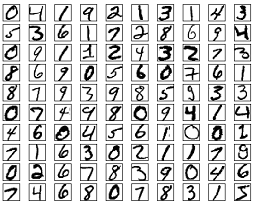可和这篇文章对比:https://blog.csdn.net/fanzonghao/article/details/81603367
# coding: utf-8
# # TensorFlow卷积神经网络(CNN)示例 - 原生API
# ### Convolutional Neural Network Example - Raw API
#
#
# ## CNN网络结构图示
#
# 
#
# ## MNIST数据集
#
#
# 
#
# More info: http://yann.lecun.com/exdb/mnist/
# In[1]:
from __future__ import division, print_function, absolute_import
import tensorflow as tf
# Import MNIST data,MNIST数据集导入
from tensorflow.examples.tutorials.mnist import input_data
mnist = input_data.read_data_sets("/tmp/data/", one_hot=True)
# In[2]:
# Hyper-parameters,超参数
learning_rate = 0.001
num_steps = 500
batch_size = 128
display_step = 10
# Network Parameters,网络参数
num_input = 784 # MNIST数据输入 (img shape: 28*28)
num_classes = 10 # MNIST所有类别 (0-9 digits)
dropout = 0.75 # Dropout, probability to keep units,保留神经元相应的概率
# tf Graph input,TensorFlow图结构输入
X = tf.placeholder(tf.float32, [None, num_input])
Y = tf.placeholder(tf.float32, [None, num_classes])
keep_prob = tf.placeholder(tf.float32) # dropout (keep probability),保留i
# In[3]:
# Create some wrappers for simplicity,创建基础卷积函数,简化写法
def conv2d(x, W, b, strides=1):
# Conv2D wrapper, with bias and relu activation,卷积层,包含bias与非线性relu激励
x = tf.nn.conv2d(x, W, strides=[1, strides, strides, 1], padding='SAME')
x = tf.nn.bias_add(x, b)
return tf.nn.relu(x)
def maxpool2d(x, k=2):
# MaxPool2D wrapper,最大池化层
return tf.nn.max_pool(x, ksize=[1, k, k, 1], strides=[1, k, k, 1],
padding='SAME')
# Create model,创建模型
def conv_net(x, weights, biases, dropout):
# MNIST数据为维度为1,长度为784 (28*28 像素)的
# Reshape to match picture format [Height x Width x Channel]
# Tensor input become 4-D: [Batch Size, Height, Width, Channel]
x = tf.reshape(x, shape=[-1, 28, 28, 1])
# Convolution Layer,卷积层
conv1 = conv2d(x, weights['wc1'], biases['bc1'])
# Max Pooling (down-sampling),最大池化层/下采样
conv1 = maxpool2d(conv1, k=2)
# Convolution Layer,卷积层
conv2 = conv2d(conv1, weights['wc2'], biases['bc2'])
# Max Pooling (down-sampling),最大池化层/下采样
conv2 = maxpool2d(conv2, k=2)
# Fully connected layer,全连接网络
# Reshape conv2 output to fit fully connected layer input,调整conv2层输出的结果以符合全连接层的需求
fc1 = tf.reshape(conv2, [-1, weights['wd1'].get_shape().as_list()[0]])
fc1 = tf.add(tf.matmul(fc1, weights['wd1']), biases['bd1'])
fc1 = tf.nn.relu(fc1)
# Apply Dropout,应用dropout
fc1 = tf.nn.dropout(fc1, dropout)
# Output, class prediction,最后输出预测
out = tf.add(tf.matmul(fc1, weights['out']), biases['out'])
return out
# In[4]:
# Store layers weight & bias 存储每一层的权值和全差
weights = {
# 5x5 conv, 1 input, 32 outputs
'wc1': tf.Variable(tf.random_normal([5, 5, 1, 32])),
# 5x5 conv, 32 inputs, 64 outputs
'wc2': tf.Variable(tf.random_normal([5, 5, 32, 64])),
# fully connected, 7*7*64 inputs, 1024 outputs
'wd1': tf.Variable(tf.random_normal([7*7*64, 1024])),
# 1024 inputs, 10 outputs (class prediction)
'out': tf.Variable(tf.random_normal([1024, num_classes]))
}
biases = {
'bc1': tf.Variable(tf.random_normal([32])),
'bc2': tf.Variable(tf.random_normal([64])),
'bd1': tf.Variable(tf.random_normal([1024])),
'out': tf.Variable(tf.random_normal([num_classes]))
}
# Construct model,构建模型
logits = conv_net(X, weights, biases, keep_prob)
prediction = tf.nn.softmax(logits)
# Define loss and optimizer,定义误差函数与优化器
loss_op = tf.reduce_mean(tf.nn.softmax_cross_entropy_with_logits(
logits=logits, labels=Y))
optimizer = tf.train.AdamOptimizer(learning_rate=learning_rate)
train_op = optimizer.minimize(loss_op)
# Evaluate model,评估模型
correct_pred = tf.equal(tf.argmax(prediction, 1), tf.argmax(Y, 1))
accuracy = tf.reduce_mean(tf.cast(correct_pred, tf.float32))
# Initialize the variables (i.e. assign their default value),初始化图结构所有变量
init = tf.global_variables_initializer()
# In[5]:
# Start training,开始训练
with tf.Session() as sess:
# Run the initializer,初始化
sess.run(init)
for step in range(1, num_steps+1):
batch_x, batch_y = mnist.train.next_batch(batch_size)
# Run optimization op (backprop),优化
sess.run(train_op, feed_dict={X: batch_x, Y: batch_y, keep_prob: dropout})
if step % display_step == 0 or step == 1:
# Calculate batch loss and accuracy
loss, acc = sess.run([loss_op, accuracy], feed_dict={X: batch_x,
Y: batch_y,
keep_prob: 1.0})
print("Step " + str(step) + ", Minibatch Loss= " + "{:.4f}".format(loss) + ", Training Accuracy= " + "{:.3f}".format(acc))
print("Optimization Finished!")
# Calculate accuracy for 256 MNIST test images,以每256个测试图像为例,
print("Testing Accuracy:", sess.run(accuracy, feed_dict={X: mnist.test.images[:256],
Y: mnist.test.labels[:256],
keep_prob: 1.0}))
